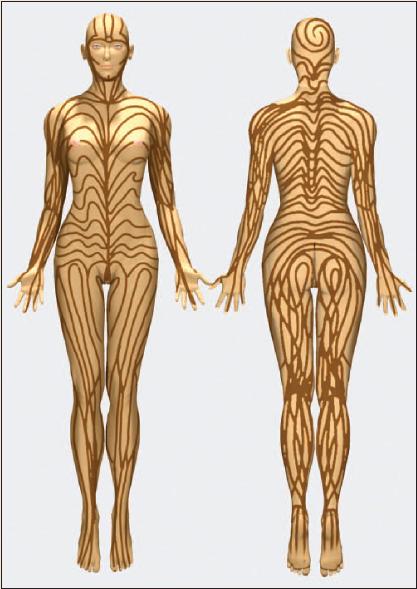Blaschko's lines
Last reviewed 04/2022
Blaschko's lines, also called the Lines of Blaschko, are skin lines invisible under normal conditions
- thought to represent pathways of epidermal cell migration and proliferation
during the development of the fetus
- become apparent when some diseases of the skin or mucosa manifest themselves according to these patterns
- Blaschko lines are consistently V-shaped on the upper spine, S-shaped
on the abdomen, inverted U-shaped from the breast area to the upper arm,
and perpendicular down the front and back of the lower extremities
- they never cross the anterior truncal midline but run along it. These lines are invisible but many inherited and acquired diseases of skin manifest themselves according to these patterns creating the visual appearance of these lines

- they do not correspond to nervous, muscular, or lymphatic systems
- can be observed in other animals such as cats and dogs
- German dermatologist Alfred Blaschko is credited for the first demonstration
of these lines in 1901
- Many inherited and some acquired skin conditions are distributed along Blaschko
lines
-
Congenital Disorders X-linked dominant skin disorders Incontinentia pigmenti Focal dermal hypoplasia
CHILD syndrome
MLS syndrome
Oral facial digital syndrome
Type 1 X- linked dominant chondroplasia punctata
Epithelial naevi Inflammatory linear verrucous epidermal naevus
Sebaceous naevus
Non-organoid epidermal naevus
Pigmentary disorders Naevus achromicus (including hypomelanosis of Ito)
McCune-Albright syndrome
Segmental vitiligo
-
Acquired disorders Disorders with polygenic background Linear lichen planus
Linear cutaneous lupus erythematosus
Lichen striatus
Linear morphoea
-
Reference:
- Blaschko's lines- Wikipedia, the free encyclopaedia
- Textbook of Dermatology .Ed Rook A, Wilkinson DS, Ebling FJB, Champion RH, Burton JL. Fourth edition. Blackwell Scientific Publications.